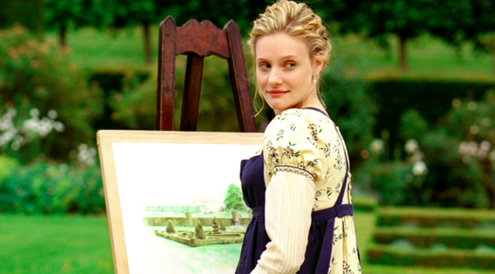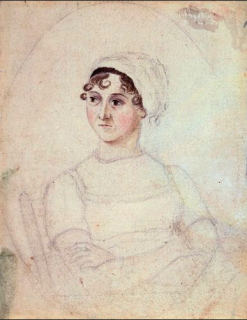
Regency ladies with a drawing pad
When studying a woman’s role in the Regency era, one truly appreciates the great strides today’s Western women have made in making personal choices and leading interesting and independent lives. In Jane Austen’s day, women from all walks of life were constrained by their family, society’s mores, and unfair laws that prevented all but a blessed handful from the rights to their children or owning property.
If you watched Regency House Party, a 2004 reality TV show (Wall to Wall/Channel 4) you would have seen the boredom of the modern young women who reenacted the lives of upper crust Regency women. Overseen by a strict chaperone, their days were indolent, filled with long periods of visiting, reading, walking, sewing, painting lessons, music lessons, dance lessons, meals, naps, and letter writing.

Modern women reenact Regency ladies in Regency House Party, 2004.
In Regency House Party, the women were forced to follow a prescribed daily schedule, while the men slept late, caroused late, hunted, fished, played sports, drank and ate and lived their lives on a whim. The modern young women found this unfair. Their days were not only long and boring, but if they broke a minor rule, they were punished and kept to the house.

Gertrude Saville, unhappy spinster, At Home with the Georgians, Amanda Vickery
The situation was worse for single ladies. The diaries of spinsters are filled with laments – unable to work or own property, they depended on the largesse of families. Many were deeply depressed. I imagine they found some solace in pursuing the arts, as Anne Elliot did when she played the piano for her family, and Cassandra Austen, when she painted portraits of those she loved. As a wife, a woman had some standing as a head of household and as a mother (if she bore children). Many spinsters rotted deep inside the cores of their beings from lack of direction, affection, and true meaning in their lives.
Even if a woman demonstrated extraordinary talent as an artist, let’s say, the game was fixed. She would not be allowed to attend life drawing classes at a proper Academy of the Arts, but would be forced to draw the likenesses of statues. If she had the good luck of being the daughter of an open minded artist, then she would learn everything he knew about preparing canvasses, mixing paints, drawing from nature, and other tricks of the trade. This was an exception, however.

Detail, Regency Selfie of I.J. Willis, 1830’s
Most children of the gentry learned from drawing or painting masters either at home or in school. Some were better than others, but the overall effect of their instruction was tepid. Women tended to paint what they knew – flowers, gardens, interiors, family scenes of the lives they lived, portraits and self-portraits, etc. This detail of a 1830’s Self Portrait of the Artist Painting at her Desk by I.J Willis is typical of the era and in many ways reminiscent of Jane Austen’s writing desk in the dining room at Chawton Cottage – domestic, cozy, and feminine.

Rolinda Sharples with her mother, Regency selfie, 1817
Miss (or Mrs.) Willis sits facing her mirror in 3/4 pose (typical of the selfies of the day.) She has placed her flowers, paintbox, water, and paper in front of her. It is obvious she is painting from life. The self-portrait is quite accomplished. I rather like it is much as Rolinda Sharple’s selfie with her mother, Self-portrait by Rolinda Sharples, with her mother, Ellen, 1817. Rolinda is well-known, I. J. Willis is not. The quote below, made by three clergy men, explains why so many paintings and drawings that countless women in the Georgian, Regency, and Victorian eras made have disappeared:
…when a young lady, who has neither eyes, nor ear, is completed to drudge at music and drawing, the result of her labors is discomfort to herself, and annoyance to the friends and strangers who are summoned to witness her proficiency; and whom if they possess any relish for the fine arts, are embarrassed between their unwillingness to bestow hypocritical praise, and to utter unwelcome truth.” – Artisan or Artist: A History of the Teaching of Art and Crafts in English Schools, Gordon Sutton, Elsevier, May 12, 2014, p.33.
Mary Bennet’s piano playing can best be described by the above quote, and while one can appreciate that the only portrait painted from life was drawn by her sister Cassandra, by no stretch of the imagination can we term the portrait of Jane Austen at the National Gallery in London “accomplished.” (Heresy!) The portrait has value only because it was drawn from life and because it is one of a handful that are undeniably of Jane. One wishes it were as good as the portrait of Cassandra’s niece, Fanny Austen-Knight, painting at a table. This watercolor by a woman depicting another woman painting with watercolors is interesting. Fanny needed very little to paint – a table, a glass of water, and a box of watercolors. I can’t quite tell if she is painting from imagination or from a model in front of her. All I know is that, while a few of Cassandra’s watercolors survived, I have yet to see any of Fanny’s – the inevitable fate for most womens’ paintings. Few have survived. Few are in art history books or museums.Few are larger than life. Cassandra’s watercolor portrait of Jane Austen is so tiny that I walked past it several times while actively looking for it.

Diana Sperling’s painting shows the carpet rolled up. One can imagine Anne Elliott playing the pianoforte at this gathering.
Diana Sperling’s wonderful watercolors are cherished for their depiction of Regency family life in the country, but her talent, though undeniable, was homegrown and not influenced by rigorous academic training. In this wonderfully descriptive painting, she depicts the family dancing and the carpets rolled up. It is delightful but amateurish, but we don’t care. These domestic products of a young woman’s observations are priceless. Diana was probably taught by one of the many drawing or painting masters of the day who taught young ladies the accomplishments of painting and drawing. They could be found in towns like Meryton and in abundance in a town like Bath, where the rising middle class clamored for, well, class.
Some painting masters were more talented than others, and they could make a decent living if they found a permanent gig. From 1814 – 1819, David Cox made a respectable living as drawing master at Miss Croucher’s Academy for Young Ladies. He earned £100 per year for twice weekly lessons, as well as 7 s. 6 d. – 10 s. for private lessons. (Gordon Sutton, p. 35). Obviously, Mr. Cox did not become wealthy as a drawing master, and one wonders how often he had to bite his tongue as he taught a class of talentless young ladies.

Romola Garai as Emma at her easel
One can tell a great deal about Jane Austen’s female protagonists through their talents. Emma’s sheltered but cosseted life is reflected in her artistic abilities. She never needed to overly exert herself to win praise, and so she doesn’t bother to complete her drawings or paintings. Elinor Dashwood is made of sterner, deeper stuff. Her paintings are accomplished. One imagines that they might even be better than Cassandra Austen’s paintings, but we’ll never know. I have not had the pleasure of reading Jane Austen’s critique of her sister’s work or Elinor’s, for that matter.
Below, is Jane’s masterful scene in Sense and Sensibility. Elinor and Marianne Dashwood finally meet the formidable Mrs. Ferrars. All the characters are true to form – a despicable Fanny, a haughty Mrs. Ferrars, a hen-pecked John Ferrars, a love-sick Colonel Brandon, a reticent, self-effacing Elinor, a fiery, audacious Marianne, and a kind, clueless Lady Middleton – and play a role in the scene. The topic is Elinor’s painted screens:
Before her removing from Norland, Elinor had painted a very pretty pair of screens for her sister-in-law, which being now just mounted and brought home, ornamented her present drawing-room; and these screens catching the eye of John Dashwood on his following the other gentlemen into the room, were officiously handed by him to Colonel Brandon for his admiration.
“These are done by my eldest sister,” said he; “and you, as a man of taste, will, I dare say, be pleased with them. I do not know whether you ever happened to see any of her performances before, but she is in general reckoned to draw extremely well.”
The Colonel, though disclaiming all pretensions to connoisseur ship, warmly admired the screens, as he would have done anything painted by Miss Dash wood; and the curiosity of the others being of course excited, they were handed round for general inspection. Mrs. Ferrars, not aware of their being Elinor’s work, particularly requested to look at them; and after they had received the gratifying testimony of Lady Middleton’s approbation, Fanny presented them to her mother, considerately informing her at the same time that they were done by Miss Dashwood.
“Hum “—said Mrs. Ferrars—” very pretty,”—and without regarding them at all, returned them to her daughter.
Perhaps Fanny thought for a moment that her mother had been quite rude enough,—for, colouring a little, she immediately said,
“They are very pretty, ma’am—a’n’t they?” But then again, the dread of having been too civil, too encouraging herself, probably came over her, for she presently added,
“Do you not think they are something in Miss Morton’s style of painting, ma’am? She does paint most delightfully. How beautifully her last landscape is done!”
“Beautifully indeed. But she does everything well.”
Marianne could not bear this. She was already greatly displeased with Mrs. Ferrars; and such ill-timed praise of another, at Elinor’s expense, though she had not any notion of what was principally meant by it, provoked her immediately to say with warmth,
“This is admiration of a very particular kind! What is Miss Morton to us? Who knows or who cares for her? It is Elinor of whom we think and speak.”
And so saying, she took the screens out of her sister-inlaw’s hands to admire them herself as they ought to be admired.
Mrs. Ferrars looked exceedingly angry, and drawing herself up more stiffly than ever, pronounced in retort this bitter philippic: “Miss Morton is Lord Morton’s daughter.”
Fanny looked very angry too, and her husband was all in a fright at his sister’s audacity. Elinor was much more hurt by Marianne’s warmth, than she had been by what produced it; but Colonel Brandon’s eyes, as they were fixed on Marianne, declared that he noticed only what was amiable in it; the affectionate heart which could not bear to see a sister slighted in the smallest point.
Excerpt From: Jane Austen. “Sense and Sensibility.” iBooks.

Victorian hand-held paper screens, Ruby Lane
This image shows two hand-held, hand-painted Victorian face screens from Ruby Lane. They were used to shelter a lady’s face from the heat of a fire. Back in the Georgian era, such screens prevented thickly applied makeup from melting and running down a person’s face. Elinor’s screens were probably not as accomplished, but good enough for John Ferrars to pay attention to them.

Young Woman Drawing by Marie-Denise Villers
The reality was that only a few truly talented and lucky women were able to free themselves from the straight jackets with which society constrained them. Even so, a few are renowned today. Click here for an article by Leslie An McCleod.
- My Pinterest board on Regency Woman’s work shows a number of paintings and illustrations of Regency women painting and drawing.









